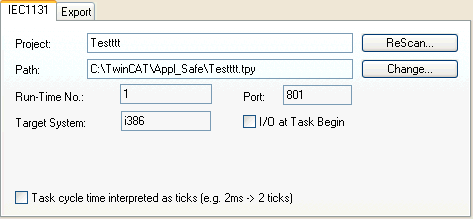Generating a PLC Configuration
Select PLC Configuration in the tree view of the System Manager and then right click on the mouse to open the corresponding context menu.
Context menu:

Append IEC Project
Opens a dialog to select and add a PLC project to the configuration.
Paste
Adds the PLC project which is currently on the clipboard to the configuration.
Paste with Links
Command does the same like Paste, but tries to restore available variable links.
"IEC61131" tab
When a project was generated with TwinCAT PLC Control without errors and then saved, a PLC configuration can be added to the current system configuration and the I/O variables with address locations are read in. When you select the added PLC project in the tree the associated dialogue IEC1131 appears on the right-hand side.

Project
Shows the name of the currently selected PLC project.
Path
Defines the path of the current PLC project. This path indicates the PLC project currently being edited.
The path points to a *.tpy file. File names with the extension *.tpy are XML files that contain information about the variables present in the PLC project which are bound to addresses and their underlying data types, as well as general project information.
The XML based *.tpa files, which hold the finally resolved addresses from possible variable_configurations or global_variables-lists with accordingly localized variables (%I* and/or %Q*), and which are uniquely available for each project, are new. The assigned addresses are displayed in the Resources area | "TwinCAT_Configuration (VAR_CONFIG)" in TwinCAT PLC Control.
Runtime no.
Indicates the runtime system that the selected PLC project is configured for. Settings changes can be carried out under
Port
Defines the AMS Port Number of the run-time system. The number shown depends on the Run-time Number described above.
Target System
Defines the target system for which the respective PLC code was generated. If the PLC is running on the PC, code i386 is generated.
I/O at Task Begin
An I/O cycle is carried out at the task start. This means a jitter-free cycle of the I/O independent of the run-time of the task (normally not activated for PLC configurations).
Task cycle time interpreted as ticks
This checkbox is deactivated by default. It is only in use, when the TwinCAT Base Time differs from its default value of 1ms. This is e.g. the case, when a PLC Task interval less than 1ms is wanted.
ReScan
Re-loads the current PLC configuration into the system. Changed configurations (e.g. new I/O variables) will then appear in the System Manager configuration.
Change
This command enables the path for the PLC project to be adjusted. This is necessary if the project location has changed or if you want to activate another PLC project.
PLC Configuration - Process Image
Below the PLC project name appears an input ‘Project Name’ - Process Image (as shown below). Further information is given under: Process Images.
PLC Configuration - Task Information
If the tree below the process image is opened as shown below you will see the name of the task configured in the PLC project. The corresponding dialogue appears on the right-hand side in the System Manager, see Task Settings.

As a PLC project can comprise up to 4 tasks, several task names will appear in the corresponding multitasking projects in the tree. This is shown in the diagram below for both ‘Standard’ and ‘FastTask’ tasks.

The input and output variables are always assigned to the first task after loading the PLC project, but can also be assigned to other tasks, e.g. via Drag&Drop. This means that the values of the variables can be refreshed according to the current pre-set task cycle times.
If you select an input or output variable, this can be linked either with the context menu or the dialogue which appears on the right-hand side, via a Variable Link.
Further link and documentation functions for variable lists are described here.